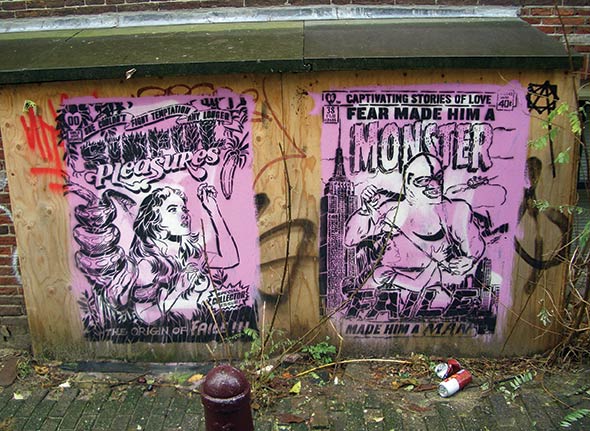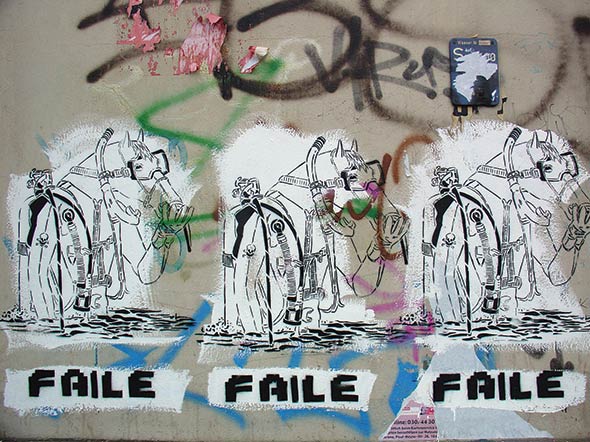

Text by Matthew Nestel
Graffiti specialist Sixten requests a flat white and a can of matte black. The white would “make the stencil pop-off the wall a bit more,” Sixten says. “Preferably purchase Belton as it dries quick.” Late night, he has to make due with a couple cans of Home Depot’s locked and carded stash of Rust-Oleum. Would it dry? Would it spray?
The crew walks into the wee hours of an unblinking crescent moon along the Brooklyn side of the East River for a few quiet moments to piece a few stencils. The depths of South Williamsburg are sparsely-lit and many of the occupied buildings are art studios and squatted lofts. Foot traffic infrequently treads through these grounds, but there still exists a neighborhood watchdog group of Stetson-wearing orthodoxy that keep vigilant eye on the goings-on. The Hebrew-speaking and undeputized clan’s mandate? Keep the hood safe.
Weapons Backpacked and Tucked In Folded Cardboard | Sixten offers a sneak peek of the munitions du jour. Inside, a torn cardboard box reveals a snowflake cutout of an attractive couple attached at the lips. Streaks and colored dust on the white cutups placate the stencil’s indoor tests. Outdoors, it comes down to plotting the spot.
A few hundred yards from the rally point there is a redbrick building with handy grottos. A perfect blend of shade and working light. “It could use a paint job,” Sixten says. With a fellow femme teammate keeping a few strips of duct tape on her thighs and another helper on lookout for roaming strollers and cars, Sixten goes to work. For the most part the only cars that are in proximity are sitting dormant with brake lights on and a driver and his 50 bucks going to the town of Fellatio.
The warnings of “Hey Rick!” which are code for “Car is coming!” are unattended to. A resident of a neighboring complex comes outside and sees the smooching man and woman image on the wall. He asks, “Who did this?” Sixten’s comrade responds deferentially, “Don’t know. But isn’t it beautiful?” The crew offs to the next spot.
Three People Enter a Bar… | The white wall gets the crew to work fast. The concerto of duct tape rips from denim and shakes of compressed mixers and inside the cans ricket back and forth.
The watchman surveys a dump truck picking up rubbish. No threat. A few vehicles approach and turn. Then a car approaches. Then another. A loud whistle fails to thwart Sixten’s unsanctioned work. A minivan quickly approaches. Glistening Rust-Oleum lays wet on the wall in stenciled-lover fashion. And the minivan is directly parallel to it. Duff’s Bar offers cover. Sixten tips the chin in silent hello to the barkeep then heads to the joint’s rear to scout an exit. No avail. The rest straggle in. A look outside and the man in the minivan is unmoved, dialing numbers on speakerphone. Seven-digit numbers? Or the 911 sort?
A wash of the hands, a memory card switch-up and a stiff drink serves up as if everyone were following script. Another peek out the window and the car remains inert, the motor running. Two abettors leave prematurely after only a sip or two of their Red Stripes. Sixten and female cohort modify wardrobe and play tipsy lovers in direct mimesis to the stencil itself. A few paces, a few long kisses. Until home.
Sixten goes MIA for 24 hours. Says Sixten, “This is what gives it some spice.”
Ephemeral Fits of Fancy | Willem De Kooning once belted in an interview, “Content is a glimpse of something, an encounter like a flash. It’s very, very tiny content.” The stencil exists in the fringe. Works manufactured in Photoshop or simply photoscanned images are later screened and adapted with cutups and slapped on as wheat-pastes or blended with paints to create messages that run typographic to pictographic to the current blasts of iconographic.
The arousal to get up and stay up on the urban canvas of New York City takes the merger of the daring and the creative to inconspicuously reclaim the space that is pounded on at dawn by construction workers’ drills and tap-danced by the Wall Street elite, to the gum-spitters, the signage owners – namely Viacom and Clear Channel – who conquer the sides of buildings, payphones and billboards with advertising content ranging from iPod to Reebok. Madison Avenue has spread its wings to get into the psyches of SoHo consumers with a big gulp of seductive Calvin Klein suggestion to uptown in Harlem where bystanders get a visual dose of the Ashford & Simpson-sponsored helpline. Whatever the branded campaign, the citizen has taken back the streets during his working hours.
Tristan Manco, graphic designer based in Bristol, England, and mouthpiece book author of numerous titles, such as Stencil Graffiti and Street Logos, has traveled the world over and inhaled plenty of second-hand ozone. “These operations can be very calculated and I think very successful. It levels the playing field between the artist-individual and the advertiser-corporation,” says Manco. He adds, “To change the balance of power with an ingenious artistic intervention has to be applauded.”
Whether you take a moral stance against this visual resistance and adhere to labeling it vandalism, there is room to look at the work and what attracts the wild styles of night crawlers like Swoon and Banksy to come out and infuse interventionist tactics into the status quo. Call them “brandals” if you will, but they will call themselves the messengers of the medium. Manco sees promise ahead and a stronger caliber of work going up. “I think now we are still in the second wave of stencil graffiti art… I think many people worry about how stencils have become fashionable or whether they lose their edge but this only happens to a degree. It only takes someone to come up with a great idea and bang! You get a new stencil that you would never have thought of,” says Manco.
Well-traveled co-author of Stencil Graffiti Capital, Melbourne, Carl Nyman has been documenting the widespread stencil movement closely for some time. He takes his painting cues primarily from the Aussies and Europeans rather than New Yorkers but sees the stencil movement starting to take off stateside. To Nyman, the art of the stencil was at first pitied by the freehand writers. Today, freehanders no longer tag the stencil artist as cheaters and instead the two are a synthesis of take-no-prisoners-cluster-bombers. “It’s nothing close to as calculated as getting into the train yard to paint,” says Nyman. “From the beginning, the only thing stencil graffiti and traditional graffiti had in common was the use of spray cans and that it’s done illegally.” Drawing on punk and hip hop, Nyman believes each preaches a spontaneously strategized street gospel. “Historically, political stencils have been used way longer than the existence of the graffiti that sprung out of New York,” says Nyman. “Although it would probably never be this popular had it not been for the rise of graffiti here [in New York]. Stencils just never had the mass appeal of graffiti until recent years. Now they seem to be merging a bit. Graffers drift into stencils and stencilheads go freehand.”
Late at night, legends are scribed. In the ’60s, the boom of graffiti sprouted and certainly the ’80s delivered Keith Haring, Kenny Scharf, Richard Hambleton and Jean Michel Basquiat as mainstays. Taggers still scratch and uncommissioned muralists are unstoppable and signatured by art school punks alongside gangsters cautioning outsiders that this is their land. Pink doughnuts, pacifiers, fish leaping out of a fishbowl into somewhere better is the new breed of street aesthete. Utilizing 8-bit graphics, drop shadows, pixels, calligraphy, retro fashions, collage, stickers, acrylics, bio-technical forms, logos and animations, it’s a space that is somewhat endless. And these artists are filling in the blanks, even stuffing their work in the trash dispensers for the curious to pluck out and relish a momentary read or gaze. The impetus is to get the word out subliminally and do so ad infinitum. And folks like Faile, Obey, Logan Hicks and the now-incarcerated Borf are spraying the way for our senses to look longer and slow down our pace to see that the essentials are not always skyward or blinking in flashy lights.

